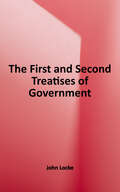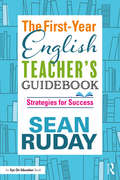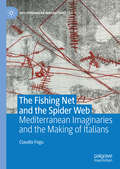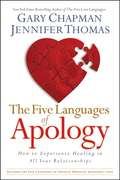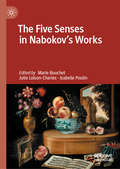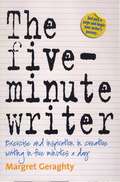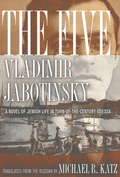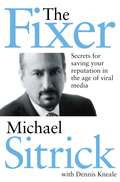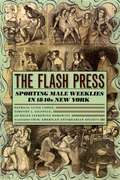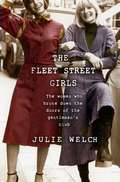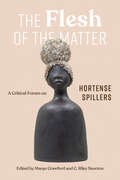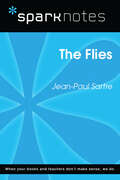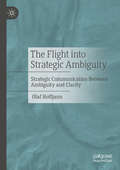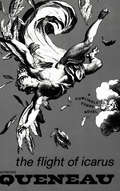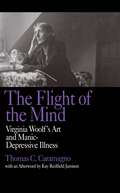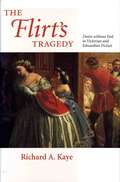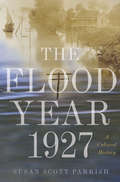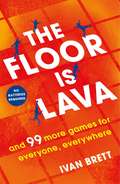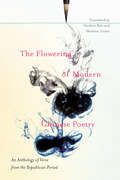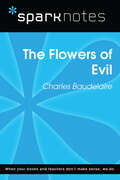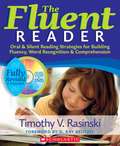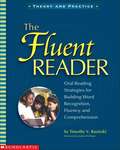- Table View
- List View
The First and Second Treatises of Government
by John LockeLocke's two groundbreaking treatises regarding good governance are present here in this complete edition. At the time these treatises were written, English politics had undergone decades of upheaval in the wake of the English Civil War. <p><p> When Dutch monarch William of Orange ascended to the English throne in the Glorious Revolution of 1688, burning questions over the best form of governance for England were prominent in the intelligentsia of the era. It was a time when England grappled with its incremental transition from monarchy to early forms of democracy and right to vote, where dynastic monarchy and religious theory still held considerable power over the formation of the state. <p><p> In the first treatise Locke proceeds to attack and dissect his prominent contemporary Robert Filmer, who was broadly in favour of absolute monarchy under the principle of divine right. The allusions to the Biblical Adam, wherein the monarch can be intimated as a continuation of the first man ever created, are debunked by Locke who asserts that God never asserted that one man had province to rule over all other human beings. Supporting his argument with known history, Locke concludes that no king over the centuries had asserted to be the heir of Adam and thereby the rightful ruler of a country. <p><p> In the second treatise Locke turns to a different topic - that of the state of nature. He discusses how humanity may have behaved prior to the establishment of formal societies, and concludes that humanity - even without an established government in place - had never been truly lawless even when freedom was at its farthest extent. In arguing against the tyranny of absolute monarchy, while acknowledging the advantages of humanity's freedom in its natural ungoverned state, Locke arrives at his conclusion: a democratically elected government, whereby humans are accorded freedoms but must conform to the rule of law, is the most advantageous type of government to which humans can aspire. <p><p> Lauded as a classic of political philosophy, the treatises by Locke are a common requirement in various educational courses concerning political science and philosophy to this day. While steeped in the historical realities of the late 17th century, the arguments Locke composes for governance favourable to the people and their country's development were immensely influential on political theory during and after the Enlightenment era.
The First-Year English Teacher's Guidebook: Strategies for Success
by Sean RudayThe First-Year English Teacher’s Guidebook offers practical advice and recommendations to help new English teachers thrive in the classroom. Each chapter introduces a concept crucial to a successful first year of teaching English and discusses how to incorporate that concept into your daily classroom practice. You’ll find out how to: Clearly communicate instructional goals with students, parents, and colleagues; Incorporate students' out-of-school interests into the curriculum; Use assignment-specific rubrics to respond to student writing in meaningful ways; Integrate technology into ELA instruction; Conduct student-centered writing conferences; Make time for self-care and self-improvement; and much, much more. Additionally, the guidebook provides a number of forms, templates, graphic organizers, and writing prompts that will enable you to put the author’s advice into immediate action. These tools are available for download on the book’s product page: www.routledge.com/9781138495708.
The Fishing Net and the Spider Web: Mediterranean Imaginaries and the Making of Italians (Mediterranean Perspectives)
by Claudio FoguThis book explores the role of Mediterranean imaginaries in one of the preeminent tropes of Italian history: the formation or 'making of' Italians. While previous scholarship on the construction of Italian identity has often focused too narrowly on the territorial notion of the nation-state, and over-identified Italy with its capital, Rome, this book highlights the importance of the Mediterranean Sea to the development of Italian collective imaginaries. From this perspective, this book re-interprets key historical processes and actors in the history of modern Italy, and thereby challenges mainstream interpretations of Italian collective identity as weak or incomplete. Ultimately, it argues that Mediterranean imaginaries acted as counterweights to the solidification of a 'national' Italian identity, and still constitute alternative but equally viable modes of collective belonging.
The Five Languages Of Apology
by Gary Chapman Jennifer ThomasREAL LIFE INVOLVES real people who make real mistakes. Sometimes saying I'm sorry"just isn't enough. The need for apologies impacts all human relationships. The good news is that you can learn the art of apology. Through their research and interaction with hundreds of individuals, counselor Dr. Jennifer Thomas and Dr. Gary Chapman author of the revolutionary The Five Love Languages, have discovered five fundamental aspects or "languages" of an apology: EXPRESSING REGRET -- "I am sorry." ACCEPTING RESPONSIBILITY -- "I was wrong." MAKING RESTITUTION --"What can I do to make it right?" GENUINELY REPENTING -- "I'll try not to do that again." REQUESTING FORGIVENESS "will you please forgive me?" In The Five Languages of Apology, you will learn how to recognize your own primary apology language while speaking the languages of those you love. Understanding and applying the five languages of an apology will greatly enhance all of your relationships.
The Five Senses in Nabokov's Works
by Marie Bouchet Julie Loison-Charles Isabelle PoulinThis collection of essays focuses on a subject largely neglected in Nabokovian criticism—the importance and significance of the five senses in Vladimir Nabokov’s work, poetics, politics and aesthetics. This text analyzes the crucial role of the author’s synesthesia and multilingualism in relation to the five senses, as well as the sensual and erotic dimensions of sensoriality in his works. Each chapter provides a highly focused and sometimes provocative approach to the unique role that sensory perceptions play in the shaping and narrating of Nabokov’s memories and in his creative process.
The Five-Minute Writer: Exercise And Inspiration In Creative Writing In Five Minutes A Day
by Margret GeraghtySuitable for writers, this title includes chapters that offers a writing-related discussion, followed by a five-minute exercise. Five minutes a day spent on an exercise is one of the most effective methods there is to expand your potential and develop self-discipline.
The Five-Minute Writer: Exercise and inspiration in creative writing in five minutes a day
by Margret GeraghtySuitable for writers, this title includes chapters that offers a writing-related discussion, followed by a five-minute exercise. Five minutes a day spent on an exercise is one of the most effective methods there is to expand your potential and develop self-discipline.
The Five: A Novel of Jewish Life in Turn-of-the-Century Odessa
by Michael R. Katz Michael Stanislawski Vladimir Jabotinsky"The beginning of this tale of bygone days in Odessa dates to the dawn of the twentieth century. At that time we used to refer to the first years of this period as the 'springtime,' meaning a social and political awakening. For my generation, these years also coincided with our own personal springtime, in the sense that we were all in our youthful twenties. And both of these springtimes, as well as the image of our carefree Black Sea capital with acacias growing along its steep banks, are interwoven in my memory with the story of one family in which there were five children: Marusya, Marko, Lika, Serezha, and Torik."--from The Five The Five is an captivating novel of the decadent fin-de-siècle written by Vladimir Jabotinsky (1880-1940), a controversial leader in the Zionist movement whose literary talents, until now, have largely gone unrecognized by Western readers. The author deftly paints a picture of Russia's decay and decline--a world permeated with sexuality, mystery, and intrigue. Michael R. Katz has crafted the first English-language translation of this important novel, which was written in Russian in 1935 and published a year later in Paris under the title Pyatero.The book is Jabotinsky's elegaic paean to the Odessa of his youth, a place that no longer exists. It tells the story of an upper-middle-class Jewish family, the Milgroms, at the turn of the century. It follows five siblings as they change, mature, and come to accept their places in a rapidly evolving world. With flashes of humor, Jabotinsky captures the ferment of the time as reflected in political, social, artistic, and spiritual developments. He depicts with nostalgia the excitement of life in old Odessa and comments poignantly on the failure of the dream of Jewish assimilation within the Russian empire.
The Fixer: Secrets for Saving Your Reputation in the Age of Viral Media
by Michael S. Sitrick"The Wizard of Spin."—Los Angeles Times"The spin doctor's spin doctor." —Financial Times"The Winston Wolf of Public Relations....Wolf, if you recall, was the fixer in Pulp Fiction. Played by Harvey Keitel, he washed away assassins' splatter and gore. Sitrick, 65, cleans up the messes of companies, celebrities, and others, and he's a strategist who isn't averse to treating PR as combat. Over the years, clients of Sitrick & Co. have included the late HP chairman Patricia Dunn, Roy Disney, Rush Limbaugh, Michael Vick, Alex Rodriguez, the Archdiocese of Los Angeles, and the Church of Scientology."—Fortune Magazine"Everyone understands the importance of shaping a story, but few are as shrewdly proficient at manipulating the media as L.A. crisis manager Mike Sitrick"—Fast CompanyWhat do you do when the reputation you've built over decades is destroyed in a day? In the court of public opinion, you're rarely innocent until proved guilty, and your enemies don't have to play by the rules.Any misstep can blow up into a worldwide embarrassment on Facebook and Twitter, land on the front page of the New York Times, and bring down a CEO, a business, or a celebrity. You need a smart strategic response. You need Mike Sitrick.In this book, Sitrick reveals the secrets that have made him America's preeminent crisis communications expert. You'll see how the PR legend and his team guided clients like the estate of Michael Jackson and Papa John's Pizza through the media-fueled fires of scandal, while helping others, like Roy Disney and the filmmakers who exposed the Russian Olympic doping scandal, achieve justice. You'll learn Sitrick's Ten Rules of Engagement and his thoughts on "no comment," social media, public apologies, and more.The question isn't whether you'll face a crisis one day, especially if you are at the top of your game. The question is what will you do when crisis comes? Don't let a lie get repeated until it's "fact," festering forever on Google. Don't let a damaging truth, stripped of nuance and context, damage your reputation forever. Follow the Fixer.
The Flash Press: Sporting Male Weeklies In 1840s New York
by Patricia Cline Cohen Helen Lefkowitz Horowitz Timothy J. Gilfoyle American Antiquarian Society StaffObscene, libidinous, loathsome, lascivious. Those were just some of the ways critics described the nineteenth-century weeklies that covered and publicized New York City’s extensive sexual underworld. Publications like the Flash and the Whip—distinguished by a captivating brew of lowbrow humor and titillating gossip about prostitutes, theater denizens, and sporting events—were not the sort generally bound in leather for future reference, and despite their popularity with an enthusiastic readership, they quickly receded into almost complete obscurity. Recently, though, two sizable collections of these papers have resurfaced, and in The Flash Press three renowned scholars provide a landmark study of their significance as well as a wide selection of their ribald articles and illustrations. <p><p> Including short tales of urban life, editorials on prostitution, and moralizing rants against homosexuality, these selections epitomize a distinct form of urban journalism. Here, in addition to providing a thorough overview of this colorful reportage, its editors, and its audience, the authors examine nineteenth-century ideas of sexuality and freedom that mixed Tom Paine’s republicanism with elements of the Marquis de Sade’s sexual ideology. They also trace the evolution of censorship and obscenity law, showing how a string of legal battles ultimately led to the demise of the flash papers: editors were hauled into court, sentenced to jail for criminal obscenity and libel, and eventually pushed out of business. But not before they forever changed the debate over public sexuality and freedom of expression in America’s most important city.
The Fleet Street Girls: The women who broke down the doors of the gentlemen's club
by Julie Welch<p>When Julie Welch called in her first ever football report at the Observer, an entire room of men fell silent. Heart in her mouth, Julie waited for the voice on the other end of the line to declare it passable. She'd done it. She was the first ever female football reporter.<p> <p>In The Fleet Street Girls, Julie looks back at the steps that led to that moment, from the National Union of Journalists nearly calling a strike when she dared to write an article as a mere secretary (despite allowing men who weren't journalists to write for the same pages), and many other battles in between.<p> <p>Julie also shines a light on the other trail-blazing women who were climbing the ladder against all odds, from Lynn Barber (of An Education fame) to Wendy Holden, a war correspondent for the Daily Telegraph, and many more, as well as some of the secretaries whom the men overlooked but who actually knew everything. Pioneers one and all.<p> <p>The Fleet Street Girls is a fascinating story of the hopes and despairs, triumphs and tribulations of a group of women in the glitzy heyday of journalism, where they could be interviewing Elton John one moment and ducking flying bullets or fighting off the sex pests the next. At a time when Fleet Street was the biggest, cosiest all-male club you can imagine, and the interests of half the human race were consigned to 'The Women's Page' in the paper, we follow Julie and her contemporaries through dramas, excitement and sheer fun in their battle to make sure women's voices were heard.<p>
The Flesh of the Matter: A Critical Forum on Hortense Spillers
by Hortense SpillersHortense Spillers is one of the most important literary critics and Black feminist scholars of the last fifty years. Her 1987 scholarly article &“Mama&’s Baby, Papa&’s Maybe: An American Grammar Book&” is one of the most-cited essays in African American literary studies. Edited by Margo Natalie Crawford and C. Riley Snorton, The Flesh of the Matter: A Critical Forum on Hortense Spillers is the first collection to take up directly how Spillers&’s writing on literature, culture, and theory have been signal posts to the varied and universal threads of Black thought, as well as countless other areas of the academy. Interspersed with archival fragments from Spillers&’s papers kept at the Pembroke Center for Feminist Thought at Brown University, the fourteen essays in this collection demonstrate a fidelity to the ways of reading Spillers has taught us, the nomenclature of enslavement keyed into the American lexicon, and the ways that history permeates our cultural boundaries today.
The Flies (SparkNotes Literature Guide Series)
by SparkNotesThe Flies (SparkNotes Literature Guide) by Jean-Paul Sartre Making the reading experience fun! Created by Harvard students for students everywhere, SparkNotes is a new breed of study guide: smarter, better, faster.Geared to what today's students need to know, SparkNotes provides:chapter-by-chapter analysis explanations of key themes, motifs, and symbols a review quiz and essay topics Lively and accessible, these guides are perfect for late-night studying and writing papers.
The Flight into Strategic Ambiguity: Strategic Communication Between Ambiguity and Clarity
by Olaf HoffjannThis book analyses how and why advertising, PR, and corporate and political communication make use of strategic ambiguity. This special quality of vagueness allows companies to talk about the relevance of ESG or governments to promise stability and prosperity without fully committing themselves, disappointing no one and securing every freedom. This book describes in detail the diverse practices of ambiguous strategic communication – and its opposite, strategic clarity – with many examples. For academics, it offers a detailed framework for describing and researching strategic ambiguity. For PR practitioners, it provides a toolbox for the use of strategic ambiguity. Lastly, it provides journalists with a means of recognizing and criticizing questionable strategic ambiguity. This book is a translation of the original German edition “Die Flucht in die Ambiguität”. The translation was done with the help of an artificial intelligence machine translation tool. A subsequent human revision was done primarily in terms of content, so that the book will read stylistically differently from a conventional translation.
The Flight of Icarus: Novel
by Raymond QueneauThe Flight of Icarus (Le Vol d'lcare) is his only novel written in the form of a play: seventy-four short scenes, complete with stage directions. Called by some the French Borges, by others the creator of le nouveau roman a generation ahead of its time, Raymond Queneau's work in fiction continues to defy strict categorization. The Flight of Icarus (Le Vol d'lcare) is his only novel written in the form of a play: seventy-four short scenes, complete with stage directions. Consciously parodying Pirandello and Robbe-Grillet, it begins with a novelist's discovery that his principal character, Icarus by name, has vanished. This, in turn, sets off a rash of other such disappearances. Before long, a number of desperate authors are found in search of their fugitive characters, who wander through the Paris of the 1890s, occasionally meeting one another, and even straying into new novels. Icarus himself--perhaps following the destiny his name suggests--develops a passion for horseless carriages, kites, and machines that fly. And throughout the almost vaudevillian turns of the plot, we are aware, as always, of Queneau's evident delight at holding the thin line between farce and philosophy.
The Flight of the Mind: Virginia Woolf's Art and Manic-Depressive Illness
by Thomas C. CaramagnoIn this major new book on Virginia Woolf, Caramagno contends psychobiography has much to gain from a closer engagement with science. Literary studies of Woolf's life have been written almost exclusively from a psychoanalytic perspective. They portray Woolf as a victim of the Freudian "family romance," reducing her art to a neurotic evasion of a traumatic childhood.But current knowledge about manic-depressive illness—its genetic transmission, its biochemistry, and its effect on brain function—reveals a new relationship between Woolf's art and her illness. Caramagno demonstrates how Woolf used her illness intelligently and creatively in her theories of fiction, of mental functioning, and of self structure. Her novels dramatize her struggle to imagine and master psychic fragmentation. They helped her restore form and value to her own sense of self and lead her readers to an enriched appreciation of the complexity of human consciousness.
The Flirt's Tragedy: Desire without End in Victorian and Edwardian Fiction
by Richard A. KayeIn the flirtation plots of novels by Jane Austen, Charlotte Brontë, and W. M. Thackeray, heroines learn sociability through competition with naughty coquette-doubles. In the writing of George Eliot and Thomas Hardy, flirting harbors potentially tragic consequences, a perilous game then adapted by male flirts in the novels of Oscar Wilde and Henry James. In revising Gustave Flaubert's Sentimental Education in The Age of Innocence, Edith Wharton critiques the nineteenth-century European novel as morbidly obsessed with deferred desires. Finally, in works by D. H. Lawrence and E. M. Forster, flirtation comes to reshape the modernist representation of homoerotic relations.In The Flirt's Tragedy: Desire without End in Victorian and Edwardian Fiction, Richard Kaye makes a case for flirtation as a unique, neglected species of eros that finds its deepest, most elaborately sustained fulfillment in the nineteenth-century and early twentieth-century novel. The author examines flirtation in major British, French, and American texts to demonstrate how the changing aesthetic of such fiction fastened on flirtatious desire as a paramount subject for distinctly novelistic inquiry. The novel, he argues, accentuated questions of ambiguity and ambivalence on which an erotics of deliberate imprecision thrived. But the impact of flirtation was not only formal. Kaye views coquetry as an arena of freedom built on a dialectic of simultaneous consent and refusal, as well as an expression of "managed desire," a risky display of female power, and a cagey avenue for the expression of dissident sexualities. Through coquetry, novelists offered their response to important scientific and social changes and to the rise of the metropolis as a realm of increasingly transient amorous relations.Challenging current trends in gender, post-gender, and queer-theory criticism, and considering texts as diverse as Darwin's The Descent of Man and Gilbert and Sullivan's The Mikado, Kaye insists that critical appraisals of Victorian and Edwardian fiction must move beyond existing paradigms defining considerations of flirtation in the novel. The Flirt's Tragedy offers a lively, revisionary, often startling assessment of nineteenth-century fiction that will alter our understanding of the history of the novel.
The Flood Year 1927: A Cultural History
by Susan Scott ParrishThe Great Mississippi Flood of 1927, which covered nearly thirty thousand square miles across seven states, was the most destructive river flood in U.S. history. Due to the speed of new media and the slow progress of the flood, this was the first environmental disaster to be experienced on a mass scale. As it moved from north to south down an environmentally and technologically altered valley, inundating plantations and displacing more than half a million people, the flood provoked an intense and lasting cultural response. The Flood Year 1927 draws from newspapers, radio broadcasts, political cartoons, vaudeville, blues songs, poetry, and fiction to show how this event took on public meanings.Americans at first seemed united in what Herbert Hoover called a “great relief machine,” but deep rifts soon arose. Southerners, pointing to faulty federal levee design, decried the attack of Yankee water. The condition of African American evacuees in “concentration camps” prompted pundits like W.E.B. Du Bois and Ida B. Wells to warn of the return of slavery to Dixie. And environmentalists like Gifford Pinchot called the flood “the most colossal blunder in civilized history.” Susan Scott Parrish examines how these and other key figures—from entertainers Will Rogers, Miller & Lyles, and Bessie Smith to authors Sterling Brown, William Faulkner, and Richard Wright—shaped public awareness and collective memory of the event.The crises of this period that usually dominate historical accounts are war and financial collapse, but The Flood Year 1927 enables us to assess how mediated environmental disasters became central to modern consciousness.
The Floor is Lava: and 99 more screen-free games for all the family to play
by Ivan Brett'A brilliant book of 100 games you can play anywhere in your house or garden.' The Sun Playing games can be so enjoyable but don't you often find yourself playing the same old games time and time again? Well, why not let Ivan Brett inspire you with over 99 games to entertain any gathering of friends or family? Inside The Floor is Lava you'll find 100 games to satisfy any busy family and most require no equipment other than pencil and paper. There's everything from fiendish brain teasers and number puzzles to witty wordplays and physical challenges. You'll find something for everyone to enjoy and avoid the whole family resorting to screen-time! In short, this is a how-to for turning time together into quality time together. It's time to put down your screens and pick up the fun! You'll find games for every occasion: * occupy the kids on rainy days* have after-dinner fun around the table * liven up a party * cool off in the summer holidays* beat boredom in the car So what are you waiting for? Jump up and get started - the floor is lava Ivan's next book Bored? Games! 101 games to make every day more playful is out in June. You can PRE-ORDER NOW!
The Floor is Lava: and 99 more screen-free games for all the family to play
by Ivan Brett'A brilliant book of 100 games you can play anywhere in your house or garden.' The Sun Playing games can be so enjoyable but don't you often find yourself playing the same old games time and time again? Well, why not let Ivan Brett inspire you with over 99 games to entertain any gathering of friends or family? Inside The Floor is Lava you'll find 100 games to satisfy any busy family and most require no equipment other than pencil and paper. There's everything from fiendish brain teasers and number puzzles to witty wordplays and physical challenges. You'll find something for everyone to enjoy and avoid the whole family resorting to screen-time! In short, this is a how-to for turning time together into quality time together. It's time to put down your screens and pick up the fun! You'll find games for every occasion: * occupy the kids on rainy days* have after-dinner fun around the table * liven up a party * cool off in the summer holidays* beat boredom in the car So what are you waiting for? Jump up and get started - the floor is lava Ivan's next book Bored? Games! 101 games to make every day more playful is out in June. You can PRE-ORDER NOW!
The Flower Alphabet Book (Jerry Pallotta's Alphabet Books)
by Jerry PallottaRoses are red,Violets are blue...And they're only two of the flowers in this book of bright colors and delightful information. Young readers will be fascinated to find out what flower can be used to make a doll, which flower flavors tea, and which flower farmers feed to chickens.Author Jerry Pallotta and illustrator Leslie Evans have collaborated to produce a stunning bouquet of words and pictures about the world of flowers–one of nature's most beautiful gifts.
The Flowering of Modern Chinese Poetry: An Anthology of Verse from the Republican Period
by Herbert Batt Sheldon ZitnerThe May Fourth Movement launched an era of turmoil and transformation in China, as Western ideas and education encroached on the Confucian traditions at the root of Chinese society. The Republican period (1919–49) witnessed an outpouring of poetry in a form and style new to China, written in the common people’s language, baihua ("plain speech"). The New Poetry broke with the centuries-old tradition of classical poetry and its intricate forms, and the rise of China’s modern poetry reflects the rise of modern China. The Flowering of Modern Chinese Poetry presents English translations of over 250 poems by fifty poets, including a rich selection of poetry by women writers, to provide a nuanced picture of the rapid development of vernacular verse in China from its emergence during the May Fourth Movement, through the years of the Japanese invasion, to the Communist victory in the Civil War in 1949. Michel Hockx introduces the historical and literary contexts of the various schools of vernacular poetry that developed throughout the period – the pioneers, formalists, symbolists, "peasants and soldiers" poets, and Shanghai poets of the late 1940s. Each selection of verse begins with a biographical sketch of the author’s life and literary career, including their roles in the Civil War and Japanese occupation. Introducing English readers to master poets who are virtually unknown to Western audiences, this anthology presents a collection of verse written in an age of struggle that attests to the courage, sensitivity, and imagination of the Chinese people.
The Flowers of Evil (SparkNotes Literature Guide Series)
by SparkNotesThe Flowers of Evil (SparkNotes Literature Guide) by Charles Baudelaire Making the reading experience fun! Created by Harvard students for students everywhere, SparkNotes is a new breed of study guide: smarter, better, faster.Geared to what today's students need to know, SparkNotes provides:chapter-by-chapter analysis explanations of key themes, motifs, and symbols a review quiz and essay topics Lively and accessible, these guides are perfect for late-night studying and writing papers.
The Fluent Reader 2nd Ed
by Timothy V. RasinskiTim Rasinski's groundbreaking book has been updated to include coverage of the latest research on fluency, teaching strategies based on that research, new classroom vignettes, and suggestions for using a variety of texts to teach fluency such as poetry, speeches, and monologues and dialogues. You'll also find background information, assessment tools, step-by-step lessons, and teaching tips--plus video clips showing the strategies in action. For use with Grades 1-8.
The Fluent Reader: Oral Reading Strategies for Building Word Recognition, Fluency, and Comprehension
by Timothy V. RasinskiThis book will make you smile with its brilliant explanations of how to teach students to read.
